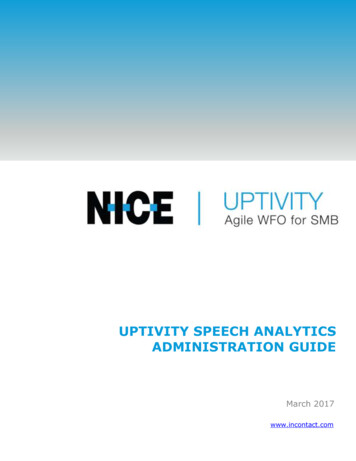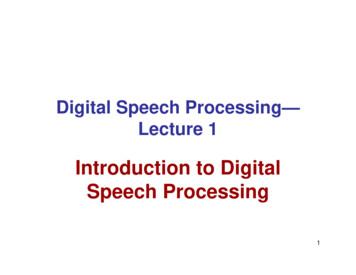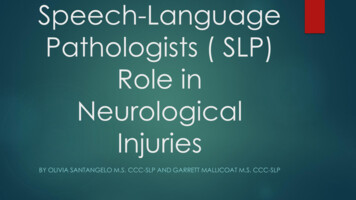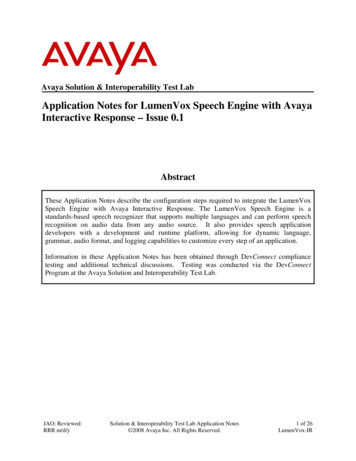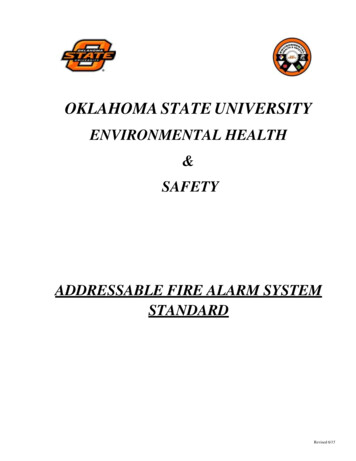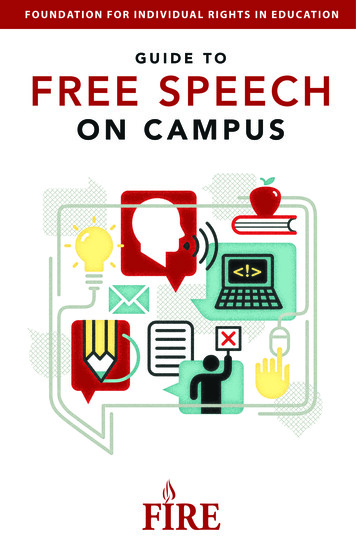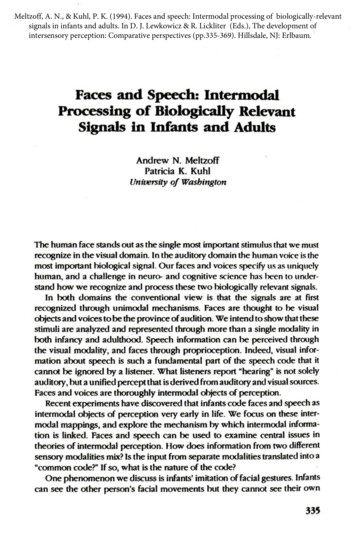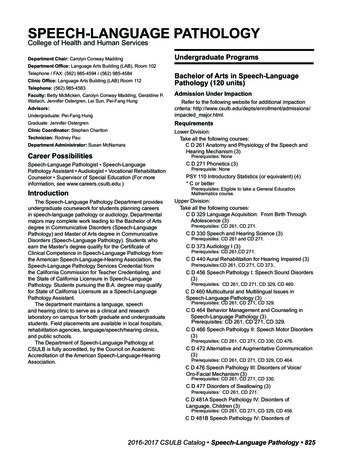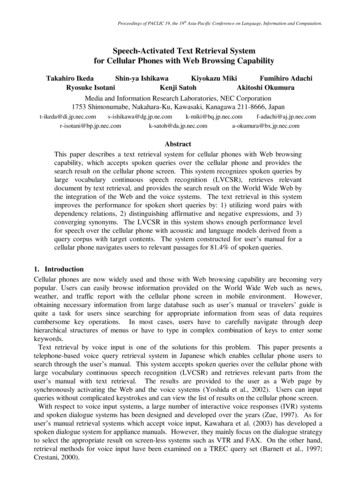
Transcription
Proceedings of PACLIC 19, the 19th Asia-Pacific Conference on Language, Information and Computation.Speech-Activated Text Retrieval Systemfor Cellular Phones with Web Browsing CapabilityTakahiro IkedaShin-ya IshikawaKiyokazu MikiFumihiro AdachiRyosuke IsotaniKenji SatohAkitoshi OkumuraMedia and Information Research Laboratories, NEC Corporation1753 Shimonumabe, Nakahara-Ku, Kawasaki, Kanagawa 211-8666, .nec.comAbstractThis paper describes a text retrieval system for cellular phones with Web browsingcapability, which accepts spoken queries over the cellular phone and provides thesearch result on the cellular phone screen. This system recognizes spoken queries bylarge vocabulary continuous speech recognition (LVCSR), retrieves relevantdocument by text retrieval, and provides the search result on the World Wide Web bythe integration of the Web and the voice systems. The text retrieval in this systemimproves the performance for spoken short queries by: 1) utilizing word pairs withdependency relations, 2) distinguishing affirmative and negative expressions, and 3)converging synonyms. The LVCSR in this system shows enough performance levelfor speech over the cellular phone with acoustic and language models derived from aquery corpus with target contents. The system constructed for user’s manual for acellular phone navigates users to relevant passages for 81.4% of spoken queries.1. IntroductionCellular phones are now widely used and those with Web browsing capability are becoming verypopular. Users can easily browse information provided on the World Wide Web such as news,weather, and traffic report with the cellular phone screen in mobile environment. However,obtaining necessary information from large database such as user’s manual or travelers’ guide isquite a task for users since searching for appropriate information from seas of data requirescumbersome key operations. In most cases, users have to carefully navigate through deephierarchical structures of menus or have to type in complex combination of keys to enter somekeywords.Text retrieval by voice input is one of the solutions for this problem. This paper presents atelephone-based voice query retrieval system in Japanese which enables cellular phone users tosearch through the user’s manual. This system accepts spoken queries over the cellular phone withlarge vocabulary continuous speech recognition (LVCSR) and retrieves relevant parts from theuser’s manual with text retrieval. The results are provided to the user as a Web page bysynchronously activating the Web and the voice systems (Yoshida et al., 2002). Users can inputqueries without complicated keystrokes and can view the list of results on the cellular phone screen.With respect to voice input systems, a large number of interactive voice responses (IVR) systemsand spoken dialogue systems has been designed and developed over the years (Zue, 1997). As foruser’s manual retrieval systems which accept voice input, Kawahara et al. (2003) has developed aspoken dialogue system for appliance manuals. However, they mainly focus on the dialogue strategyto select the appropriate result on screen-less systems such as VTR and FAX. On the other hand,retrieval methods for voice input have been examined on a TREC query set (Barnett et al., 1997;Crestani, 2000).
The InternetWebServiceModuleUser’sManualThe RetrievalModuleIndexLVCSRModuleFigure 1: The configuration of the prototype system.Figure 2: The screen of thecellular phone displaying thesearch result. However, text retrieval in TREC mainly aims to search open domain documents from longqueries, while our system is required to search closed domain documents such as user’s manualsbased on short queries spoken over the cellular phone.In order to apply text retrieval technique to speech-activated user’s manual retrieval, we haveinvestigated queries for searching manuals in addition to the text of the manuals from a linguisticviewpoint. We found that text retrieval for a user’s manual has the following three difficulties.1) The difficulty of identifying passages in a user’s manual based on an individual word.2) The difficulty of distinguishing affirmative and negative sentences which mean two differentfeatures in the manual.3) The difficulty of retrieving appropriate passages for a query using words not appearing in themanual.This paper presents how we overcome these difficulties using three techniques: 1) utilizing wordpairs with dependency relations, 2) distinguishing affirmative and negative expressions by auxiliaryverbs, and 3) converging synonyms with synonym dictionary.The rest of the paper is organized as follows. Section 2 describes the system configuration of ourspeech-activated text retrieval system and how it works. Section 3 discusses the difficulties in textretrieval in our system and presents our proposed techniques in detail. Section 4 shows thedeveloped prototype system and Section 5 reports its evaluation results. Finally Section 6 concludesthe paper.2. Speech-Activated Text Retrieval SystemOur system receives spoken queries on the usage of the cellular phone and provides the list ofrelevant passages in the user’s manual. In this paper, a passage denotes a part of the documentcorresponding to a feature in the user’s manual.2.1. System ConfigurationFigure 1 shows the configuration of our retrieval system.The telephone service module receives a phone call from the user. This module prepares the searchoperation by calling the LVCSR module, which recognizes the query spoken over the phone, and thetext retrieval module, which provides the search result for the query.
Proceedings of PACLIC 19, the 19th Asia-Pacific Conference on Language, Information and Computation.Figure 3: The main pageof our system.Figure 4: The result pagedisplaying the title list oftop ten results for thequery.Figure 5: The body ofthe passage displayedwhen the user selects thetitle in Figure 4.The telephone service module sends the list of the relevant passages to the Web service module,and then hangs up the phone. The Web service module provides the result to the user according tothe user’s request via the internet.We assume that the cellular phone screen displays about 30 letters per line and 15 lines of textaccording to the specifications of recent popular cellular phones in Japan. We assign top tenpotential passages as the search result and display the title of them in order for the user to see withease.Figure 2 shows the screen of the cellular phone displaying the search result.2.2. Example of Using the SystemThis section describes how our system works. Our system works in Japanese, but in the followingsection, English translation is provided for the reader’s convenience. In our system, the user obtainsthe relevant passage in the user’s manual with the voice query according to the following steps.Step 1: The user first accesses the system’s main page of our system with the cellular phone (Figure3). The page contains two hyperlinks along with brief instructions and query examples.Step 2: The user follows the first link labeled “Input query by voice.” It is linked to the telephoneservice module, allowing the user to call the telephone service module.Step 3: The user inputs a query following the voice guidance from the system. The LVCSR modulerecognizes it and outputs the result text. The text retrieval module searches the user’s manualfrom recognized text and outputs the top ten results. The user goes back to the main page afterthe telephone service module hangs up the phone.Step 4: The user follows the second link labeled “Show search results,” which is linked to our Webservice module. Then the user views the result page which contains the title list of top ten results(each passage consists of a title and a body). Figure 4 shows the example of the result pageresponding to the voice query “How to change my email address.”Step 5: By selecting a title of a passage from the result list, the user retrieves the correspondingbody of the passage (Figure 5). If the result list contains no relevant passages, the user can goback to the homepage and re-enter a query by speech.
3. Text Retrieval for a User’s Manual3.1. The Problems on User’s Manual RetrievalIn general, user’s manual of equipment explains all functions extensively. Since the phrasing used ina user’s manual is often similar, expressions with small difference might appear in completelydifferent entries. We have investigated queries for searching manuals in addition to the text of themanuals from a linguistic viewpoint and found that text retrieval for user’s manual has the followingthree difficulties.1) It is difficult to identify passages in a user’s manual based on an individual word. For example, aword “mail” shows up in passages explaining various functions such as sending mails, receivingmails, composing mails, and many others. In order to overcome this difficulty, we need to userelations between words.2) It is difficult to distinguish affirmative and negative sentences based on independent words.Sentences with the same set of content words can mean two different features depending onwhether the sentence is in the affirmative or in the negative. This is often true in manual writingswhere each function is described in pair: one activating and the other deactivating the function (ex.“Sending the caller number” and “Not sending the caller number”). In order to overcome thisdifficulty, we need to handle polarity indicated by auxiliary verbs.3) It is difficult to retrieve appropriate passages for a query using words not appearing in the manual.While the expression denoting an object is generally standardized in a user’s manual, users oftenindicate the object with other expressions. In order to overcome this difficulty, we need toassimilate difference of various synonymous expressions.3.2. The Approaches for User’s Manual RetrievalThe system retrieves relevant passages from the user’s manual with a word-based text retrievalmethod. The system generates indexes for content words in passages and obtains relevant passagesfrom the words in the query based on Okapi BM25 probabilistic retrieval model without relevancefeedback in principle (Robertson et al., 1993). In this model, the weight W of a passage P for aquery Q is defined as follows:W TW (T )T QTW (T ) w (k1 1) tf ( k 2 1) qtf k1 K tfk 2 qtfw logN n 0.5n 0.5K (1 b) b PLAVPLHere T denotes a term in the query Q, N denotes the number of passages in the whole text, ndenotes the number of passages containing the term T, tf denotes the frequency of occurrence of theterm T within the passage P, qtf denotes the frequency of occurrence of the term T within the queryQ, PL denotes the length of the passage P, and AVPL denotes the average length of all passages. k1,k2, and b are predefined constants.
Proceedings of PACLIC 19, the 19th Asia-Pacific Conference on Language, Information and Computation.Table 1: An example of a synonym dictionarySynonymous erodîyobidashion(ring melody)(phone beep)môichido kakeru(again call)Standard aru(redial)In order to overcome the difficulties stated previously, we have expanded the retrieval model withthe following three techniques.1) Utilization of word pairs with dependency relationsThis technique assigns larger weight for passages including the same word pairs with dependencyrelations as in the query. The system uses the following weight Wwp, which is simple extension of W:Wwp kwpNP Wwhere NP denotes the number of word pairs which appear both in the passage P and the query Qwith dependency relations. kwp is predefined constants.We detect the dependency between words by shallow dependency analysis without parsing. Thesystem assigns depend-to and depend-from attributes to each word based on its part of speech andconnects them according to the surrounding relationship (Satoh et al., 2003).2) Distinction between the negative and the affirmative phrases by auxiliary verbsThis technique assigns the different weight on the term according to the condition whether anauxiliary verb indicating negative polarity follows after the term. The system adds this condition toeach word after morphological analysis, and distinguishes words with different conditions. Thesystem uses the following weight Waux instead of W:Waux TW (T ) k aux TW (T ) TW (T ) kaux TW (T ) T Q T Qwhere T denotes the term T with this condition and T-denotes the term T without this condition.kaux is predefined constants.3) Converging synonymsThis technique assumes the occurrence of synonymous expressions for a word as the occurrence ofthe word itself in calculating the weight. The system converges various synonymous expressionsinto the standard expression by using predefined synonym dictionary. The system accepts a set ofwords with dependency relations as a synonymous expression in order to converge complexsynonymous expressions.Table 1 shows an example of a synonym dictionary. An arrow sign denotes a dependency relationbetween words.
4. Prototype SystemWe have constructed a prototype system to search through the manuals for cellular phone users(Ishikawa et al., 2004). The user’s manual contains about 14,000 passages and consists of about4,000 unique words. The prototype system works in real time according to the user’s operation.4.1. LVCSR Module4.1.1. Language ModelA statistical language model (LM) with word and class n-gram estimates is used in our system.Word 3-gram is backed off to word 2-gram, and word 2-gram is backed off to class 2-gram. Partof-speech patterns are used as the classes of each word. The LM is trained on a text corpus of querysamples for our target user’s manual. Nouns in the manual document are added to the recognitiondictionary apart from the training.A total of 15,000 queries were manually constructed and used for training the LM. The final LMfor the prototype system has about 4,000 words in the recognition vocabulary, about 20,000 word 2gram entries, and about 40,000 word 3-gram entries.4.1.2. Acoustic ModelA speech signal is sampled at 8kHz, with MFCC analysis frame rate of 10ms. Spectral subtraction(SS) is applied to remove stationary additive noises. The feature set includes MFCC, pitch, andenergy with their time derivatives. The LVCSR decoder supports triphone HMMs with tree-basedstate clustering on phonetic contexts. The state emission probability is represented by Gaussianmixtures with diagonal covariance matrices.For the prototype system, Gender-dependent acoustic models were prepared by the training on thespeech corpus with 200,000 sentences read by 1,385 speakers collected through telephone line.4.1.3. LVCSR DecoderThe LVCSR decoder recognizes the query utterances with the triphone acoustic model, thestatistical language model, and a tree-structured word dictionary. It performs two-stage processing.On the first stage, input speech is decoded by frame-synchronous beam search to generate a wordcandidate graph using the acoustic model, 2-gram language model, and the word dictionary. On thesecond stage, the graph is searched to find the optimal word sequence using the 3-gram languagemodel.Both male and female acoustic models are used and decoding is performed independently for eachmodel except for the common beam pruning in every frame. Recognition results by male and femaleacoustic models are compared and the one with better score is used as the result. Gender-dependentmodels improve the recognition accuracy while curbing the increase of the computational amount bycommon beam pruning.4.2. Text Retrieval ModuleAll the techniques described in Section 3.2 are implemented on the text retrieval module in thesystem. We fixed the constants as follows according to the preliminary experiments using querysamples developed for training the LM:k1 100, k 2 1000, b 0.3, k wp 1.3, k aux 0.3We developed the synonym dictionary with about 500 entries to converge synonymous expressionsused to describe cellular phone functions.
Proceedings of PACLIC 19, the 19th Asia-Pacific Conference on Language, Information and Computation.Table 2: Examples of queries used for evaluation.Shashin-o mêru-de okuritai(I want to send a picture via email)Aikon-o desukutoppu-ni tôroku shitai(I want to register a new icon on the desktop)Jushin-shita mêru-o minagara henshin mêru-o sakusei-suru hôhô(How to write a reply mail while looking at the incoming mail)Table 3: The retrieval success rate for the transcriptions of queries.Number ofResultPassages1510Retrieval Success Rate for TranscriptionsBLWPWP %49.1%77.3%87.3%Table 4: The retrieval success rate for the utterances of queries.Number ofResult Passages1510Retrieval Success Ratefor Utterances44.3%72.5%81.4%5. EvaluationIn order to evaluate the usefulness of our system, we have composed 150 new queries independentlyof the query corpus used for configuring the system. We have used 110 queries for evaluation,eliminating 40 queries without relevant passages in the manual. Table 2 shows some examples of thequeries used for the evaluation. Each query contains 3.8 words in average.The retrieval success rate, which we adopted as a criterion, measures how well the system is able toprovide a relevant passage within the top predefined number of result passages. We have calculatedthe retrieval success rates at 1, 5, and 10 passages for several conditions.In order to discuss the effect of each technique presented in Section 3.2, we first present the resultfor transcriptions of the queries among the following text retrieval methods.Method BL: This is the baseline method with no techniques applied.Method WP: This method utilizes word pairs with dependency relations.Method WP AUX: This method distinguishes between the negative and the affirmative phrases byauxiliary verbs in addition to the method WP.Method ALL: This method converges synonyms in addition to the method WP AUX. This is thesame condition as the prototype system.Table 3 summarizes the result. The result shows each of the three techniques has contributed tothe improvement of the retrieval success rate. Especially, converging synonyms enhances theperformance as derived from the difference between methods WP AUX and ALL.
Next we present the performance of the total system. Table 4 shows the result for 660 utterancesof the queries by 18 speakers where the LVCSR module and the text retrieval module in theprototype system are used. The retrieval success rates for utterances are almost the same as thosefor transcription. Since the cellular phones used in this system can display about 10 lines on theaverage, the 10th retrieval rate represents the rate of successfully delivering the passage requested bythe user. The result shows that the system designed for cellular phone user’s manual was able todirect user to appropriate information at 81.4%, which is sufficient for practical use.6. ConclusionsIn this paper, we presented a voice query retrieval system in Japanese applied to document search onuser’s manual for cellular phones with Web access capability. The system recognizes user’s naturallyspoken queries over the cellular phone by LVCSR and retrieves the relevant passages by textretrieval and then provides the output on the cellular phone screen. In order to improve theperformance for spoken short queries, we apply three techniques into text retrieval: 1) utilizing wordpairs with dependency relations, 2) distinguishing affirmative and negative expressions, and 3)converging synonyms. With respect to LVCSR for speech over the cellular phone, we adoptacoustic and language models derived from a query corpus for the target user’s manual. Theevaluation on the system designed for cellular phone user’s manual shows that the system is able todirect users to appropriate data at 81.4% of the time, if the matching passage exists in the manual.Our next step is to apply this system to different contents such as travelers’ guide and customersurveys. We plan to clarify the problems for different contents and to enhance the portability of thissystem.ReferencesBarnett, J., S. Anderson, J. Broglio, M. Singh, R. Hudson, and S. W. Kuo. 1997. Experiments inSpoken Queries for Document Retrieval. Proceedings of Eurospeech’97, pp.1323–1326.Crestani, F. 2000. Word recognition errors and relevance feedback in spoken query processing.Proceedings of the Fourth International Conference on Flexible Query Answering Systems,pp.267–281.Ishikawa, S., T. Ikeda, K. Miki, F. Adachi, R. Isotani, K. Iso, and A. Okumura. 2004. Speechactivated Text Retrieval System for Multimodal Cellular Phones. Proceedings of ICASSP2004.Kawahara, T., R. Ito, and K. Komatani. 2003. Spoken Dialogue System for Queries on ApplianceManuals using Hierarchical Confirmation Strategy. Proceedings of Eurospeech 2003,pp.1701–1704.Robertson, S. E., S. Walker, S. Jones, M. Hancock-Beaulieu, and M. Gatford. 1995. Okapi atTREC-3. Proceedings of the 3rd Text Retrieval Conference (TREC-3), pp.109–126.Satoh, K., T. Ikeda, T. Nakata, and S. Osada. 2003. Design and Development of JapaneseProcessing Middleware for Customer Relationship Management. Proceedings of the 9thAnnual Meeting of The Association for Natural Language Processing, pp.109–112 (inJapanese).Yoshida, K., H. Hagane, K. Hatazaki, K. Iso, and H. Hattori. 2002. Human-Voice Interface. NECResearch & Development, 43(1), pp.33–36.Zue, V. 1997. Conversational Interfaces: Advances and Challenges. Proceedings ofEurospeech ’97, KN9–18.
r-isotani@bp.jp.nec.com k-satoh@da.jp.nec.com a-okumura@bx.jp.nec.com Abstract This paper describes a text retrieval system for cellular phones with Web browsing capability, which accepts spoken queries over the cellular phone and provides the search result on the cellular phone screen. This system recognizes spoken queries by
